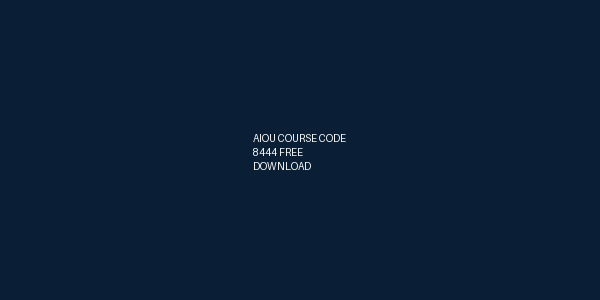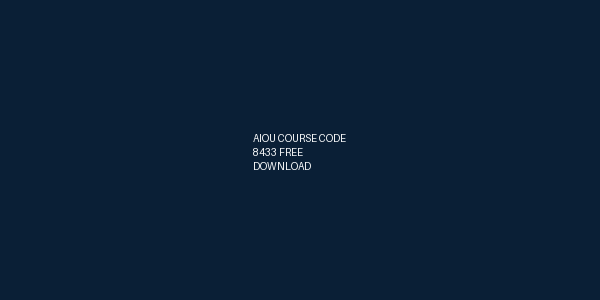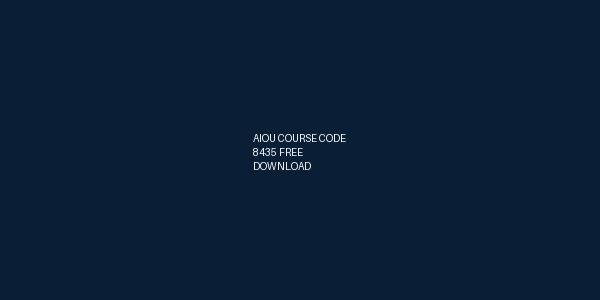AIOU Course Code 8444 Free Download

ALLAMA IQBAL OPEN UNIVERSITY ISLAMABAD
(Department of Business Administration)
WARNING
- PLAGIARISM OR HIRING OF GHOST WRITER(S) FOR SOLVING THE ASSIGNMENT(S) WILL DEBAR THE STUDENT FROM THE AWARD OF DEGREE/CERTIFICATE IF FOUND AT ANY STAGE.
- SUBMITTING ASSIGNMENTS BORROWED OR STOLEN FROM OTHER(S) AS ONE’S OWN WILL BE PENALIZED AS DEFINED IN “AIOU PLAGIARISM POLICY”.
Course: Banking Law and Practice (8444) Semester: Spring, 2025
Level: BBA
Total Marks: 100 Pass Marks: 50
ASSIGNMENT No. 1
Note: Attempt all questions.
Q. 1 What is a bank? Discuss the various types of banks with examples. (20)
Q. 2 What are the various functions of a banker in view of banker and customer relationship? Discuss with examples. (20)
Q. 3 How does a commercial bank maintain accounts clubs? Discuss with examples. (20)
Q. 4 What are the distinguishing features of a Cheque? Discuss with examples.(20)
Q. 5 What are the various parties involved in the bill of exchange? Discuss the role of each party with examples. (20)
Total Marks: 100 Pass Marks: 50
ASSIGNMENT No. 2
Q.1 What is hypothecation? Discuss the process of hypothecation examples. (20)
Q.2 What are the variable reserve requirements for credit in your view? Discuss with examples. (20)
Q.3 What is Musharika? Discuss the requirements of Musharika with examples. (20)
Q.4 What are the rights and liabilities of opening a banker in respect of a letter of credit? Discuss with examples. (20)
Q.5 What are the distinguishing features of the State Bank of Pakistan Act, of 1956? Discuss with examples. (20)
BANKING LAW AND PRACTICE
COURSE OUTLINE (BBA-8444)
UNIT 1: INTRODUCTION TO BANKING IN THE WORLD AND PAKISTAN
Evolution of Banking, Early Growth, Modern Banking, Development of Modern Banking, Types of Banks, Development of Banding in America, Banking during Muslim Rule in India, The Emergence of Public Banks in India, Joint Stock Bank, Exchange Banks, The Imperial Bank of India, The Reserve Bank of India, Post-World War Indian Banking, Banking in Pakistan.
UNIT 2: TYPES OF DEPOSITS/ACCOUNTS AND BANKER-CUSTOMER RELATIONSHIP
Deposit, Nature of deposits (Accounts) such as Current, Term Deposits, Term Deposits in Joint Names, Saving Deposits, Call, Short Notice Deposits and Pak Rupee Non-Resident Accounts, Foreign Currency Accounts, Importance and Mobilization of Deposits in Banking System, Bankers, Functions of the Banker, Customer, Qualifications of Customer, Rights and Obligations of Customer Towards the Banker, General Relationship, Other Relationships, Special Features of Relationship, Right to lien, Right of Set off, Banker’s Duty of Secrecy, Termination of Relationship
UNIT 3: ACCOUNTS OF GENERAL AND SPECIAL CUSTOMERS
Accounts of Genera customers: Introduction and preliminary Investigation, Specimen Signature, married Women, Pardanashin Women, Minor Accounts, Individual Accounts, Joint Accounts.
Accounts of Special customers: partnership Firms, Joint Stock Companies, Accounts of Clubs, Societies, and Associations, Agents Accounts, Trust Accounts, Executor and Administrators Account, and Accounts of Local Bodies.
UNIT 4: CHEQUES, PROMISSORY NOTE, AND BILL OF EXCHANGE
Cheques: Definition, Types of Cheques, The Requisites of a Cheque, parties to a Cheque; Promissory Note; Bill of Exchange: Parties to a Bill of Exchange, Types of Bills; Banker’s Draft, Pay Order, Telegraph Transfers, Mail Transfers, Travellers Cheques etc.
UNIT 5: CREDIT OPERATIONS IN BANKS
Principles and Forms of Lending: principles of Lending; Forms of Lending Cash Finance, Overdraft; Loans – Bridge and Participation Loans, Purchase and Discounting of Bills
Securities for Advances: Classification of Securities, Banker’s Lien, Charge, Contract of pledge, Hypothecation, Guarantees, indemnity
UNIT 6: CONTROL OF BANK CREDIT IN PAKISTAN
Bank Rate, open Market Operation, Variable Reserve Requirements, Selective Credit Control, National Credit Consultative Council, Small Loans Scheme, Agricultural Finance, Industrial Finance, Export Finance, Export Finance Scheme
UNIT 7: DEVELOPMENT OF ISLAMIC BANKING IN PAKISTAN
- Main features of the Islamic Economic System
- System of Interest Free Banking and Implementation in Pakistan
- Modes of Non-Interest Financing
(i) Financing by Lending:
(a) Qard-e-Hasna
- Loans with Service Charges
(ii) Trade Related Modes:
(a) Purchase of Trade Bills
(b) Purchase and Sale of Goods on Mark up Basis
(c) Financing for the Development of a Property on the Basis of “Development Charge”.
(d) Purchase of Goods/Immovable Property under Buy-back Agreements
(e) Hire Purchase
(f) Leasing
(iii) Investment Type modes:
(a) Musharika
(b) Participating Term and Modaraba Certificates
- Equity Participation
- Rent Sharing
UNIT 8: AN INTRODUCTION TO FOREIGN EXCHANGE
Why Foreign Exchange? Foreign Exchange Control in Pakistan, Mechanism of Foreign Exchange,
Letters of Credit (L/C): Definition, Classes of Letters of Credit – Documentary letters of Credit, Revocable and Irrevocable Letters of Credit, Revolving Letters of Credit, Back to Back Credit, Deferred payment Credit, Acceptance Terms Credit, Advantages of letter of Credit, Rights and Liabilities of Opening Banker and Negotiating Banker, negotiation of Documents, Remittance Against Imports, Forward Exchange Contract, Forward Cover Against Exports
UNIT 9: AN INTRODUCTION TO BANKING LAWS IN PAKISTAN
- Negotiable Instruments Act, 1881
- State Bank of Pakistan Act, 1956
- Banking Companies Ordinance, 1962
- Banks (Nationalization) Act, 1974
- Foreign Exchange Regulation Act, 1947
BOOK RECOMMENDED
Practice and Law of Banking in Pakistan, by Dr. Asrar H. Siddiqi
======

